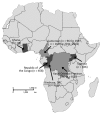Serologic Prevalence of Ebola Virus in Equatorial Africa
- PMID: 31002071
- PMCID: PMC6478206
- DOI: 10.3201/eid2505.180115
Serologic Prevalence of Ebola Virus in Equatorial Africa
Abstract
We conducted a serologic survey of 2,430 serum samples collected during 1997-2012 for various studies to determine the prevalence of the hemorrhagic fever virus Ebola virus (EBOV) in equatorial Africa. We screened serum samples for neutralizing antibodies by using a pseudotype microneutralization assay and a newly developed luciferase immunoprecipitation system assay. Specimens seroreactive for EBOV were confirmed by using an ELISA. Our results suggest a serologic prevalence of 2%-3.5% in the Republic of the Congo and the Democratic Republic of the Congo, which have reported outbreaks of infection with EBOV. In addition we detected a seroprevalence of 1.3% in southern Cameroon, which indicated a low risk for exposure in this region.
Keywords: Cameroon; Democratic Republic of the Congo; ELISA; Ebola virus; Ghana; Republic of the Congo; Uganda; equatorial Africa; filovirus; hemorrhagic fever; hemorrhagic fever virus; luciferase immunoprecipitation system; neutralization assay; pseudotypes; serologic prevalence; viruses.
Figures





Similar articles
-
Zoonotic risk factors associated with seroprevalence of Ebola virus GP antibodies in the absence of diagnosed Ebola virus disease in the Democratic Republic of Congo.PLoS Negl Trop Dis. 2021 Aug 12;15(8):e0009566. doi: 10.1371/journal.pntd.0009566. eCollection 2021 Aug. PLoS Negl Trop Dis. 2021. PMID: 34383755 Free PMC article.
-
A serological survey of Ebola virus infection in central African nonhuman primates.J Infect Dis. 2004 Dec 1;190(11):1895-9. doi: 10.1086/425421. Epub 2004 Nov 3. J Infect Dis. 2004. PMID: 15529251
-
High prevalence of IgG antibodies to Ebola virus in the Efé pygmy population in the Watsa region, Democratic Republic of the Congo.BMC Infect Dis. 2016 Jun 10;16:263. doi: 10.1186/s12879-016-1607-y. BMC Infect Dis. 2016. PMID: 27286990 Free PMC article.
-
Ebola virus circulation in Africa: a balance between clinical expression and epidemiological silence.Bull Soc Pathol Exot. 2005 Sep;98(3):210-7. Bull Soc Pathol Exot. 2005. PMID: 16267963 Review.
-
Achieving cross-reactivity with pan-ebolavirus antibodies.Curr Opin Virol. 2019 Feb;34:140-148. doi: 10.1016/j.coviro.2019.01.003. Epub 2019 Mar 15. Curr Opin Virol. 2019. PMID: 30884329 Free PMC article. Review.
Cited by
-
High Seroreactivities to Orthoebolaviruses in Rural Cameroon: A Case-Control Study on Nonhuman Primate Bites and a Cross-sectional Survey in Rural Populations.J Infect Dis. 2024 Nov 15;230(5):e1067-e1076. doi: 10.1093/infdis/jiae399. J Infect Dis. 2024. PMID: 39126336 Free PMC article.
-
Seroreactivity against Marburg or related filoviruses in West and Central Africa.Emerg Microbes Infect. 2020 Jan 8;9(1):124-128. doi: 10.1080/22221751.2019.1709563. eCollection 2020. Emerg Microbes Infect. 2020. PMID: 31913767 Free PMC article.
-
Serological Evidence of Filovirus Infection in Nonhuman Primates in Zambia.Viruses. 2021 Jun 30;13(7):1283. doi: 10.3390/v13071283. Viruses. 2021. PMID: 34209295 Free PMC article.
-
Update on known and emergent viruses affecting human male genital tract and fertility.Basic Clin Androl. 2024 Mar 14;34(1):6. doi: 10.1186/s12610-024-00222-5. Basic Clin Androl. 2024. PMID: 38486154 Free PMC article. Review.
-
Risk Factors for Ebola Exposure in Health Care Workers in Boende, Tshuapa Province, Democratic Republic of the Congo.J Infect Dis. 2022 Sep 4;226(4):608-615. doi: 10.1093/infdis/jiaa747. J Infect Dis. 2022. PMID: 33269402 Free PMC article.

